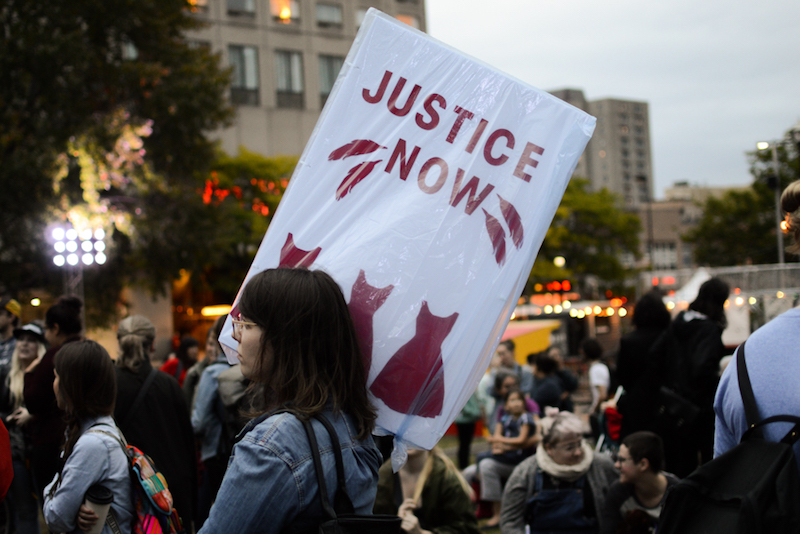Hundreds gathered for 12th annual vigil to remember the missing and murdered
Dreary weather wasn’t enough to stop hundreds of people from gathering in downtown Montreal on Wednesday, Oct. 4 to honour Canada’s missing and murdered Indigenous women.
The two-hour memorial event, held at Place Émilie-Gamelin, was coordinated by the Quebec Native Women’s Shelter and Missing Justice, a grassroots solidarity organization focused on Indigenous women’s issues. Throughout the evening, there were speeches in both English and French from various activists and family members of victims.
According to a 2014 RCMP report, there were 1,181 cases of homicide or long-term disappearances involving Indigenous women between 1980 and 2012. In 2015, Statistics Canada released data suggesting that, while Indigenous people make up just five per cent of Canada’s population, they are the victims of nearly one quarter of all of the country’s homicides.
Chelsea Obodoechina, a representative of Missing Justice, spoke about these horrifying statistics at the vigil, noting that the issue extends beyond women.
“This phenomenon […] is also affecting Indigenous boys and young men,” Obodoechina said. “And we keep them in our hearts tonight.”
According to the Native Women’s Association of Canada (NWAC), Montreal’s annual vigil was one of many held across the country on Oct. 4. The NWAC claims that, when the vigils were first held in 2006, there were only 11 held nationally. Since 2014, over 200 vigils remembering missing and murdered Indigenous women have been organized across Canada every year.
Ellen Gabriel, a Mohawk activist, also spoke at the vigil and reflected on the increased participation, noting that there were only 20 attendees at the first event in Montreal 11 years ago.
Despite the increased attention to the issue and the launch of a 28-month national inquiry in 2016, Gabriel reminded the audience that there is a long road ahead before Indigenous women—and Indigenous communities as a whole—receive justice.
“There are more [Indigenous] children in the child welfare system today than there were in residential schools,” Gabriel said. “Justin Trudeau recently gave a speech to the United Nations talking about Indigenous people […] but he’s presented no solutions on his part.”
Throughout the evening, attendees lit candles and some even brandished signs with phrases including “Justice For Our Women and Girls” and “Sisters in Spirit.” One speaker at the event asked those gathered to raise their hand if they knew a woman with the same name as some of the women who had been murdered or gone missing in Quebec since 1980. By the end of her list of about a dozen names, the overwhelming majority of the crowd had their hands up.
Cheryl McDonald, a Mohawk woman whose sister, Carleen, went missing over Labour Day weekend in 1988 in Akwesasne, also spoke at the vigil. She talked about how Carleen’s body had been found several weeks later by a hunter. Although McDonald was visibly emotional while recounting the story of her sister, her speech remained hopeful.
“We, as women, have to stop hurting each other before we can expect men to,” McDonald said. “I choose to live and leave a trail of love behind me.”
While it may have been a night of mourning, the speakers reminded the audience that it was also a night of remembrance, resilience and hope.
“We will remember these women,” Gabriel said in her closing remarks, “and we will continue to fight.”
Photos by Mackenzie Lad
